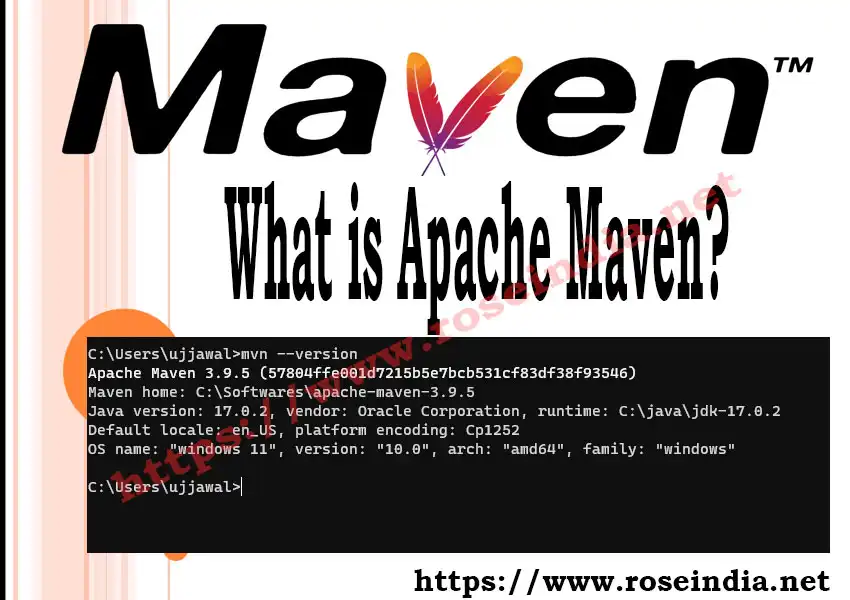Maven - What is Apache Maven?
Apache Maven is one of the popular projects at Apache Software Foundation and is under active development. Apache Maven is also known as simply Maven and being used by the developers around the world. Maven is helping developers in managing the project management aspects such as compiling code, testing code, packaging code and even deploying on the dev/test/production servers. So, it's very important for the developers to learn the Apache Maven project management tool. In this tutorial we are going to explain Apache Maven and you will learn What is Apache Maven and how its used by developers? Let's get started with the Apache Maven.

Maven is a Apache Software Foundation project for build automation mainly for Java projects. The major advantage of Maven is the dependencies management in the project. Maven manages the dependencies in the project and automatically downloads the jar field for the project. In this tutorial you will learn all the features and benefits of using Maven in your Java project. As a Java developer you must learn to use the Maven project for building your project.
What is Apache Maven?
Apache Maven or simply Maven is a popular software build automation tool mainly for the Java projects, but it can also be used to build C#, Ruby, Scala, and other languages. The Apache Maven was part of the Jakarta Project, which later moved to the Apache Software Foundation.
Maven is a software project management tool that addresses two aspects namely: how software is built and its dependencies. Maven uses an XML based configuration file for managing the project, in this file build process and project dependencies are defined. So, using the XML based configuration file you will be able to automatically build software projects. Maven based projects are well standardised and developers use almost similar project structures for their project. So, it becomes very easy for new developers to understand the pre-existing project.
The XML configuration file used in the Maven project defines all the project dependencies, external modules and components to be used in the project. It also defines the build order, directories and required plug-ins to be used in the project.
Maven automatically downloads the project dependency file from the Maven 2 Central Repository or any repository if used in the project. Maven saves the downloaded dependency files in the local cache of the computer. For further build process Maven uses the dependency files from the local cache.
There are other tools such as Apache Ivy, Gradle, SBT, Grape, Leiningen and Buildr, which uses the dependencies configuration and build process just like Maven, but these tools are not using XML files for project configuration. These build tools also download the project dependencies from the Maven repositories.
What is POM in Maven?
POM stands for project object model and it's simply the XML file used in Maven for configuring the project build process. In every Maven based project you have to create a pom.xml file and here only you have to add dependencies, Artifacts and build process.
Ant is another build tool but Maven is a much more advanced tool. There are many advantages of Maven over Ant build tools.
What are the challenges of manual project setup?
If you don't want to use the Maven then you may face following issues with your project:
Adding Jars in project: It's very difficult to add the correct jars required in the project.
Project Structure: If you do it manually then you will find it very difficult to create the project structure.
Building and Deploying project: You will find it very difficult to build and deploy projects manually.
Maven project management tool solves all these types of problems faced by the Java developers.
What are features and benefits of Apache Maven?
Apache Maven is a powerful, popular and feature rich project management tool for the Java developers (primarily). Let's see the features and benefits of Apache Maven.
Dependency Management
Dependency Management is one of the powerful features of Maven and it simplifies the task of developers in managing the dependencies in their project. Once you define the project dependencies in the pom.xml file of the project, Maven automatically downloads the required jars and other artifacts during the build time of the project. Maven also knows well to manage the dependencies among all the included dependencies.
Build Lifecycle Management
Maven streamline the project build process with the help of a series of predefined phases also known as build lifecycle. Maven follows the standard build lifecycle phases like compilation of the code, unit testing of the code, packing and finally deploying on the host system/server. Maven automates all these steps, which in turn increases the productivity of the developers.
Standard naming convention and project structure
Maven projects are well standardised and follow standard naming convention, and project structure. This helps in making all the projects in the same way.
Support for Plug-ins
There are many plug-ins available for the various activities like code analysis, code generation, code testing, checking code standard and so on. These already available plug-in help developers in managing their project build cycle easily and efficiently.
What can Maven do?
Maven is used to perform following activities:
Builds - Build projects
Documentation - Generate documentation for the project
Reporting - Generate various reports such as code quality for
the project
SCMs - Common API and source code management
Releases - Project releases
Distribution - Distribution of package software
Maven simplifies project build, test, package and deployment process for the developers.
Related Maven Tutorials
